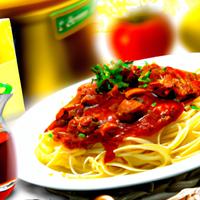
1 serving (300 grams) contains 350 calories, 15.0 grams of protein, 10.0 grams of fat, and 45.0 grams of carbohydrates.

Log this food in SnapCalorie

Nutrition Information
Calories |
280.0 | ||
|---|---|---|---|
% Daily Value* |
|||
| Total Fat | 8.0 g | 10% | |
| Saturated Fat | 2.4 g | 12% | |
| Polyunsaturated Fat | 0 g | ||
| Cholesterol | 24 mg | 8% | |
| Sodium | 480 mg | 20% | |
| Total Carbohydrates | 36 g | 13% | |
| Dietary Fiber | 2.4 g | 8% | |
| Sugars | 4.0 g | ||
| protein | 12 g | 24% | |
| Vitamin D | 0 mcg | 0% | |
| Calcium | 40.0 mg | 3% | |
| Iron | 1.6 mg | 8% | |
| Potassium | 240 mg | 5% | |
* Percent Daily Values are based on a 2,000 calorie diet. Your daily values may be higher or lower depending on your calorie needs.
Food Attributes
Source of Calories
About Spaghetti bollonaise
Spaghetti Bolognese is a classic Italian pasta dish featuring spaghetti served with a rich, savory meat-based sauce known as ragù alla Bolognese. Originating from Bologna, Italy, the sauce typically consists of minced beef or pork, tomatoes, onions, garlic, carrots, celery, olive oil, and a blend of herbs and spices, often simmered with red wine for depth of flavor. High in protein from the meat, this dish also provides energy from the pasta's carbohydrates. The inclusion of vegetables like tomatoes and carrots adds vitamins A and C, fiber, and antioxidants. However, traditional recipes can be high in saturated fats depending on the type of meat used and the amount of oil, and the pasta may contribute to a high glycemic index. For a healthier version, opt for lean ground meat, whole-grain pasta, and olive oil in moderation, while increasing the vegetable content for added nutrients.



